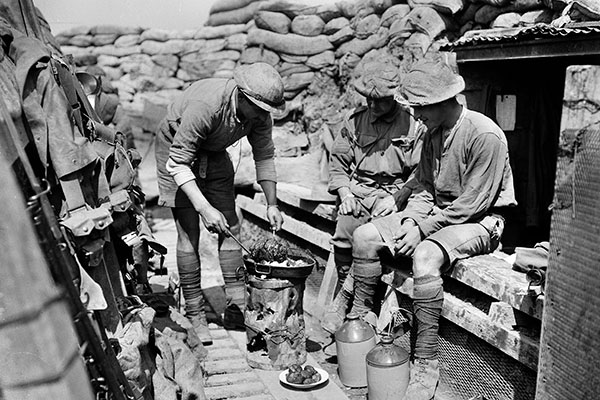Anzac diet not good enough to sustain soldiers
We remember their fighting reputation but Anzacs earned it despite a diet bereft of physiological and emotional nourishment, the first systematic study of Great War food provisions shows.
While meeting cultural and scientific nutrition standards, the Australian army diet “suffered from a number of grievous flaws” ranging from nutritional imbalance, to poor preparation and “a failure to recognise the crucial social-emotional role of food for soldiers,” writes historian Professor Daniel Reynaud in a paper published in the latest issue of the journal First World War Studies.
A generous daily allowance of rations—that tended to reflect foods associated with manliness—gave soldiers more than 4000 calories a day. In theory. The practice is more difficult to prove because objective primary sources are lacking. Ration tables indicate what the army should have issued but are disputed. Unit diaries and other official sources “are silent on the vital matter of the feeding of soldiers.” Documents about supply and catering “appear to have been considered so unimportant that they were only partially archived.” The bottom line: “rations ranked below ammunition and horse feed in the army’s delivery priorities.” So, Daniel read other historical, sociological and cultural studies of food, society and war and the diaries and letters of more than 1200 members of the Australian Imperial Force.
What the soldiers said about their diet
The frank comments in the latter suggest the Australians wrote honestly about food. Some admired the quantity and quality. “I often think what a lot of money it must take to feed an army, as we are all very well fed,” wrote an appropriately-named Leslie Tucker. Camp food in Egypt, particularly the supply of plump fresh vegetables, impressed Tom Wade. “As for tucker, we get better fed than in Australia.”
Letters like these may have been attempts to reassure family at home but Daniel found too many examples of blunt reporting. With a disproportionate number of meals prepared from emergency rations, one soldier just two months into his service complained about the endless “bully beef which one gets sick of. Bully, bully, bully.” Limited skills of typically inept company cooks—who boiled carrots for several hours—ensured too many meals were the “eternal” and “inedible” stew. Hot meals were often cold when delivered to those in the trenches. Fresh food was not fresh after moving through long supply lines in hot weather. Perishable items would spoil because of rough handling by careless soldiers. And many considered theft from army stores as “something of a badge of honour.” “Grumbling about army food is probably as old as armies themselves,” writes Daniel.
How the army failed the soldiers
No wonder. Combined with too much salt and iron and the absence of leafy greens, the high fat-and-protein diet disrupted digestion and led to constipation. Insufficient clean drinking water, poor sanitation, a lack of dietary fibre, and vitamin deficiencies made things worse. While inadequacies in the diet are clear, though, “officials were mostly operating according to best-known practice,” writes Daniel.
Concerned with costs and economies at the expense of a satisfying diet, the army, Daniel found, failed in two key areas: physiological and social. Low-level malnutrition promoted lethargy, reduced immunity, lowered morale, and retarded wound recovery. And food preparation and consumption suffered from the limitations of being neither a dining out nor dining in experience. Food is not just a matter of calories but “part of a complex socio-emotional-psychological reality that deeply influenced peoples’ attitudes, well-being and sense of identity.”
The soldiers “limited the damage,” though. Comparatively high pay meant they could experiment more with exotic food. A willingness to pilfer and raid fields and orchards supplied fruit and vegetables. And a freer culture of criticism—when asked by an officer if he had not signed up to fight for his country, one protester against the dust and dirt in his food replied, “Yes, but I didn’t enlist to eat it”—sometimes improved standards.
But army food continued to disappoint, “leaving an overwhelming impression of being limited to just a few ingredients, and in practice not being much better.” The “monotonous nature” of the diet, “compounded by a complacent high command and mediocre cooks, added to the dreariness of much of army life, leaving an indelible impression on the soldiers.”
Daniel’s paper resolves one other thing, which will perhaps feed a historic but friendly rivalry. When it comes to confronting a change to food culture, the Australians “appear more resilient than their British cousins.”
Invite Daniel to your classroom
You’re a history teacher who likes to engage students. Invite Professor Daniel Reynaud to take a lesson about the Great War Anzacs, their representation in early Australian films, or their attitudes to religion and food.
CONTACT USShare

